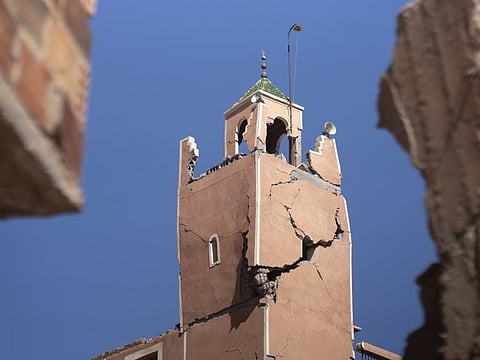Quake in Morocco damages historic buildings in Marrakesh
12th century Koutoubia Mosque with 69-meter minaret known as ‘roof of Marrakesh’ damaged

MARRAKESH: A rare, powerful earthquake that struck Morocco toppling buildings in mountainous villages and ancient cities not built to withstand such force.
The magnitude-6.8 quake, the biggest to hit the North African country in 120 years, brought down walls made from stone and masonry, covering whole communities with rubble.
The devastation gripped each town along the High Atlas’ steep and winding switchbacks in similar ways: homes folding in on themselves and mothers and fathers crying as boys and helmet-clad police carried the dead through the streets.
Remote villages like those in the drought-stricken Ouargane Valley were largely cut off from the world when they lost electricity and cellphone service.
By midday, people were outside mourning neighbors, surveying the damage on their camera phones and telling one another “May God save us.”
Hamid Idsalah, a 72-year-old mountain guide, said he and many others remained alive but had little future to look forward to. That was true in the short-term — with remnants of his kitchen reduced to dust — and in the long-term — where he and many others lack the financial means to rebound.
“I can’t reconstruct my home. I don’t know what I’ll do. Still, I’m alive, so I’ll wait,” he said as he walked through the desert oasis town overlooking red rock hills, packs of goats and a glistening salt lake. “I feel heartsick.”
In historic Marrakesh, people could be seen on state TV clustering in the streets, afraid to go back inside buildings that might still be unstable.
The city’s famous Koutoubia Mosque, built in the 12th century, was damaged, but the extent was not immediately clear. Its 69-meter (226-foot) minaret is known as the “roof of Marrakesh.”
Moroccans also posted videos showing damage to parts of the famous red walls that surround the old city, a Unesco World Heritage site.
“The problem is that where destructive earthquakes are rare, buildings are simply not constructed robustly enough to cope with strong ground shaking, so many collapse, resulting in high casualties,” said Bill McGuire, professor emeritus of geophysical and climate hazards at University College London.
Police, emergency vehicles and people fleeing in shared taxis spent hours traversing unpaved roads through the High Atlas in a stop-and-go matter, often exiting their cars to help clear giant boulders from routes known to be rugged and difficult long before Friday’s earthquake.
In Ijjoukak, a village in the area surrounding Toubkal, North Africa’s tallest peak, residents estimated nearly 200 buildings had been levelled.
Felt like a bomb
Couch cushions, electric cords and grapes were strewn in giant piles of rubble alongside dead sheep, house plants and leaning doors wedged between boulders. Relatives from the town and those who had driven from major cities cried while they wondered who to call as they reckoned with the aftermath and a lack of food and water.
“It felt like a bomb went off,” 34-year-old Mohammad Messi said.
In an exceptional move, neighbouring rival Algeria offered to open its airspace to allow eventual humanitarian aid or medical evacuation flights to travel to and from Morocco. Algeria closed the airspace when its government severed diplomatic ties with Morocco in 2021 over a series of issues. The countries have a decadeslong dispute involving the territory of Western Sahara.
Earthquakes are relatively rare in North Africa. Lahcen Mhanni, Head of the Seismic Monitoring and Warning Department at the National Institute of Geophysics, told 2M TV that the earthquake was the strongest ever recorded in the region.
In 1960, a magnitude 5.8 tremor struck near the Moroccan city of Agadir and caused thousands of deaths. That quake prompted changes in construction rules in Morocco, but many buildings, especially rural homes, are not built to withstand such tremors.
In 2004, a 6.4 magnitude earthquake near the Mediterranean coastal city of Al Hoceima left more than 600 dead.
Friday’s quake was felt as far away as Portugal and Algeria, according to the Portuguese Institute for Sea and Atmosphere and Algeria’s Civil Defense agency, which oversees emergency response.
Sign up for the Daily Briefing
Get the latest news and updates straight to your inbox



